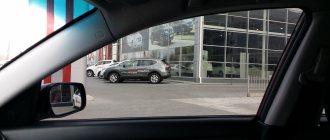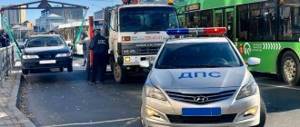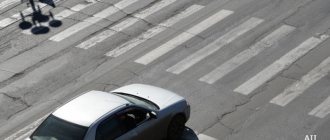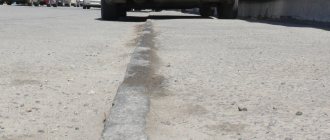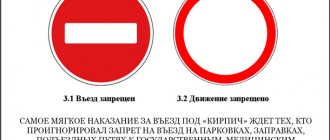Fine for towing a car in 2021
Legislation determines when a car can be prevented from being sent to the impound lot.
- According to Article 27.13, Part 1.1 of the Code of Administrative Offenses of the Russian Federation, the driver has the right to pick up a car loaded on a tow truck if the latter has not yet driven off. Traffic police officers are required to lower the vehicle from the platform and hand it over to the owner. He, in turn, must eliminate the reason for the evacuation and park the car correctly. In this case, the driver only pays the fine for illegal parking.
- Article 27.13, Part 3 of the Code of Administrative Offenses of the Russian Federation states that a tow truck cannot start moving until the employee receives a copy of the protocol on the detention of the car until it is sealed. It takes from 5 to 10 minutes to complete the paperwork. This is often enough for the owner to return to the vehicle and prevent repossession.
If the car evacuation process is disrupted, the owner can file a claim against the company that carried out the procedure and demand monetary compensation. The fine sometimes reaches 20,000 rubles.
To return the vehicle, you need to come to the duty station and contact the inspector who made the arrest. You should take from him a copy of the protocol on the administrative violation, the certificate of acceptance and transfer of the car to the impound lot and a certificate allowing you to pick up the car. You need to have with you:
- registration certificate;
- rights;
- MTPL insurance.
If the documents are left in the glove compartment of the car, you will have to go to the parking lot, write an application for access to the car interior and pick up the papers. You should return with them to the duty station and take a protocol with permission allowing you to return the vehicle.
The owner's representative, in addition to the main documents, must present a power of attorney certified by a notary, which gives the right to represent the owner's interests in government bodies.
What documents regulate the procedure for detaining a vehicle?
The rules for the detention and evacuation of vehicles are regulated by the Federal Law “On Road Traffic Safety”, as well as the Code of Administrative Offenses of the Russian Federation. Both of these documents were amended in 2015 and 2021, respectively.
The essence of the changes dated June 8, 2015:
- The detained vehicle is returned to a person who can drive it directly at the scene of the violation if the reason for the detention is eliminated. That is, if the car was parked incorrectly, but the driver managed to return before the car was taken away, the vehicle is returned to his disposal. But if the tow truck has already started moving, the car can only be picked up from the impound lot.
- An official (traffic police inspector) must remain at the place where the car was detained until it is evacuated. The amendment was adopted so that the driver, if he has time, can return his vehicle, because only the person who made the arrest can return the car to the owner.
- If the official does not comply with the owner’s request to return the vehicle to him before the tow truck starts moving (provided that he can drive it), he is subject to a fine of 20,000 rubles.
- Evacuation is provided for parking in a disabled spot.
- If there is no sign under the signs “Stopping and parking prohibited” or “Parking prohibited” indicating the operation of a tow truck, it is impossible to detain the vehicle.
The essence of the changes from September 1, 2021:
- Reimbursement for vehicle towing costs can be paid after the vehicle is collected from the impound lot.
- The owner or the person replacing him is required to provide a copy of the detention protocol, even if the protocol itself was drawn up without his participation.
- Tariffs for evacuation services and the presence of vehicles in impound lots are subject to state regulation.
Cost of towing a car to an impound lot
You can pick up your vehicle from the impound lot without prepayment. Storage and movement of the car is paid for within 60 days.
If you pay for moving and storage before returning the vehicle, you will receive a 25% discount.
Cost of evacuation in Moscow in 2021:
| Vehicle type | Cost (in rubles) | Including 25% discount (in rubles) |
| Category A, B (up to 80 hp) | 3 000 | 2 250 |
| B (80-250 hp), cargo vehicles excluded | 5 000 | 3 750 |
| B (more than 250 hp), excluding trucks | 7 000 | 5 250 |
| D (freight, oversized excluded) | 27 00 | 20 250 |
| Oversized vehicles | 29 000 | 21 750 |
Price for storage in a parking lot per day in Moscow:
| Vehicle type | Cost (in rubles) | Including 25% discount (in rubles) |
| Category A | 500 | 375 |
| B, D (weight no more than 3.5 tons) | 1 000 | 750 |
| D (over 3.5 t), C, E | 2 000 | 1 500 |
| Oversized vehicles | 2 900 | 2 175 |
In Moscow, payment is calculated for a full day. There is no need to pay for the first day of storage.
You will also have to pay fines for violating traffic rules:
The protocol drawn up by the inspector when detaining the car must contain all the information about the evacuated car, even any visual damage and a description of the special equipment used for evacuation.
If errors or violations were made during the preparation of the document, it can be appealed within 10 days . This way you can try to avoid punishment: the protocol should be declared invalid.
If you have all the documents allowing you to pick up your long-suffering car from the impound lot, you have the right to do this at any time: the special parking lot is open 24 hours a day, seven days a week.
If the employees of the impound lot start citing lunch breaks or refuse to deal with your problem for other far-fetched reasons, call the police.
Delaying the process can result in a large sum of money . Especially when the payment is hourly.
A car cannot be towed if there are people in it . Some car owners deliberately violate the rules, remain in the car and do not respond to traffic police inspectors’ demands to leave the vehicle.
The car may not be towed, but they will provide you with a fine for disobedience to police requirements, and sometimes disobedience is followed by administrative arrest.
If you find your car being towed away, you can still pick up the vehicle. If you have returned and have not yet signed the vehicle transfer certificate, the car will not be towed.
You will simply pay a fine for illegal parking. This rule works if the car owner eliminates the violation on the spot. A driver who is intoxicated will not be given a car.
You can eliminate the cause of evacuation:
- by providing the documents required by the traffic rules;
- eliminating malfunctions of the brake and other systems;
- eliminating violations of stopping and parking rules that resulted in the creation of obstacles for other cars;
- eliminating violations of the rules for the transportation of large or dangerous goods.
The cost of evacuation varies in different regions of Russia. In Moscow, the price varies from 3,000 to 29,000, depending on the type of car.
The longer you wait to return your car, the more you will pay for towing and storing the car in an impound lot.
How is a fine imposed for towing a car?
The traffic police inspector records a violation. In the capital, in addition to the traffic police, this is done by employees of the Moscow Administrative Road Inspectorate (MADI).
Draws up a protocol. If an employee of one of the services discovers that a car is parked in violation of traffic rules, he issues a report.
The protocol must indicate:
- time of violation, place and date;
- grounds for detaining a car;
- first, last and patronymic names of the inspector;
- information about the car and its owner;
- details of the evacuation employee who will take the car to a special parking lot.
A copy of the protocol is sent to the owner of the car and to the towing service.
The tow truck picks up the car. If the car owner does not show up before the tow truck leaves and does not eliminate the reason for the detention, the car will be sent to a special parking lot.
| Type of vehicle (VV) | Rate | With 25% discount |
| Category A, B with engine power up to 80 hp. (inclusive) | Tariff3520 ₽ | With a 25% discount 2640 ₽ |
| Category B with engine power over 80 hp. up to 250 hp (inclusive)Exception: trucks | Tariff5595 ₽ | With a 25% discount 4196 ₽ |
| Category B with engine power over 250 hp. c.Exception: trucks | Tariff7870 ₽ | With a 25% discount 5903 ₽ |
| Categories C and D, as well as oversized vehicles | Tariff52375 ₽ | With a 25% discount 39281 ₽ |
| Type of vehicle (VV) | Rate | With 25% discount |
| Category A | Tariff555 ₽ | With a 25% discount 416 ₽ |
| Categories B and D with a permissible maximum weight not exceeding 3.5 tons. | Tariff1085 ₽ | With a 25% discount 814 ₽ |
| Category D with a permissible maximum weight exceeding 3.5 tons, categories C and E, as well as oversized vehicles | Tariff2380 ₽ | With a 25% discount 1785 ₽ |
Oversized vehicles are those whose weight and dimensions, together with a specialized vehicle, exceed the following parameters: height more than 4 m, length more than 20 m (a load overhang of 2 m is allowed if the total length does not exceed 20 m), width more than 2.55 m, in weight with a specialized vehicle more than 38 tons.
How much is the fine for towing a car to an impound lot in 2021?
We try to make the Unified Transport Portal as convenient as possible for your use; only the most important and useful information is always at hand, and the services are simple and convenient. Help us improve by answering just a few questions.
The survey will take no more than 3 minutes. It is completely anonymous, all information received will be statistically processed and will be used only in aggregate form.
But, as often happens, the driver does not always have the documents with him, and when the car has already been taken to the impound lot, he realizes that the documents left with it, because they were in the glove compartment. We'll tell you what to do in this case!
- First, you need to drive to the penalty area, where workers will draw up the appropriate document - an autopsy report, and remove the seal from the driver's door, and you will take your documents. After all these steps, the employee will seal the car again and draw up a re-sealing report.
- And only now you can go to the traffic police or MADI, and then return to the impound area again to pick up your towed car.
Step 3
After you arrive at the traffic police department with your documents, you will receive a copy of the report on the detention of the car, a resolution, and permission to issue the car, which will need to be given to the workers of the impound area.
Now we go to the impound lot itself. They work around the clock. You can get your car back immediately, without first paying a traffic police fine or car towing services. This is stated in Article 27.13 of the Code of Administrative Offenses of the Russian Federation:
“The return of detained vehicles […] is carried out immediately after the reason for their detention has been eliminated.”
In order to pick up a car from the impound lot, you need the following documents:
- PTS;
- a copy of the arrest report;
- A driver who is not the owner, but is registered with OSAGO, must additionally present a policy and driver's license.
Step 4
At the impound lot you should be given receipts for payment of services, which include the evacuation of the car and its storage. You will also receive a receipt for payment of the fine, which can be paid within 60 days from the date of receipt. But Muscovites can get a 25% discount if they pay all the receipts before picking up the car from the impound lot.
Important ! Before you happily get into your car and drive away, conduct a thorough inspection to identify possible defects that could have appeared as a result of its loading onto a tow truck and transportation.
While you are on site and have not yet left, you have the opportunity to present your claims to the company that towed the car to the impound lot.
Services for evacuation of a car and its storage at the impound area are individually determined by the authorities of a particular region.
For example, in the capital, evacuation services are estimated at about 3,000 - 7,000 rubles (the cost is affected by engine size). In the Moscow region, the tariff is 4,227 rubles. In St. Petersburg, towing a car costs 2,700 rubles.
The same applies to the cost of storing a car at a impound lot. in Moscow, the owner of the car will have to pay 1,000 rubles for one day of downtime, in the Moscow Region - 100 rubles / hour, in St. Petersburg - 32 rubles / hour.
Note : the first day of storing a car at the impound lot is not paid for!
According to the new rules, the “violator” does not need to pre-pay for services for evacuation and storage of the vehicle. The car will be issued upon request, without advance payment. The driver will be able to repay the debt later, and if he meets a certain deadline, he will even receive a discount.
There are cases when the car was taken by a tow truck to the impound lot and later it turned out that he damaged it. To prevent this from happening to you, next time inspect your iron horse for possible defects received during transportation to the impound lot.
When receiving the car at the impound area, the driver will be asked to sign an acceptance certificate. We advise you not to rush into signing, but to conduct a thorough inspection of your vehicle.
If you find that there are any chips, scratches, or dents on the car, indicate this in the report.
The next step is to estimate the cost of repairs at the service center and demand compensation for the costs from the company that towed the car and stored it at the impound lot.
Lawyer quote:
You can write a claim to the evacuation service; in case of refusal or silence, file a claim in court. You must put a note from the evacuation service on your copy of the claim upon receipt of the claim. Refer to Article 1064 of the Civil Code. Harm caused to the person or property of a citizen, as well as harm caused to the property of a legal entity, is subject to compensation in full by the person who caused the harm. And also to Article 1068 of the Civil Code of the Russian Federation. Entity
or the citizen
compensates for the harm caused by his employee in the performance of labor (official, official) duties.
In addition to the towing service, write a claim to the parking fine; you will also need their response if there is further proceedings.
Since the activities of these organizations are subject to insurance, problems with paying compensation to the injured person will not be a big problem for them and everything will happen quite quickly.
If your demands are not met, go to court. In this case, tow truck operators will have to not only compensate for the costs associated with car repairs, but also the costs of lawyers and the court.
What to do if your car is impounded (2021): step-by-step guide
An application must be submitted to the traffic police within 10 days from the date of evacuation of the car. The authorities responsible for parking spaces in the city should be contacted within 10 days. As a rule, the processing time for an application is 5 business days.
If you decide to challenge the evacuation through court, you have 3 months to do so. During this time, you need to prepare materials on the case and attach all certificates and documents from the authorities that you applied to before.
If the court's decision is positive, the funds will be returned to the account specified in the application within 2 weeks.
As a rule, the court considers the claim for about 1-2 months. The case will go faster if the plaintiff’s interests are challenged in court by a lawyer. Moreover, he will help you file a claim in accordance with all the rules.
If the car was taken by a tow truck to the impound lot, you will need to challenge the legality of the vehicle evacuation procedure with the traffic police. For this:
- Gather your documents.
- Prepare evidence in the form of photos, videos, testimony of witnesses, if any; take screenshots of panoramas.
- Submit your complaint to the traffic police department. Support your appeal to this body with evidence.
The result of your appeal should be a written response from traffic police officers . If your appeal was ignored, contact the Prosecutor's Office.
In practice, the traffic police does not deal with complaints, and the service that towed the car does not admit its mistake. Therefore, it is advisable to immediately write a complaint to the Prosecutor’s Office.
The response will indicate what actions were taken to resolve your problem and when it will be addressed.
File a claim with the court.
As in the case of an appeal to the traffic police department, provide the necessary documents to the court and support your appeal with evidence. Indicate in the statement of claim that you require the administrative penalty to be canceled and the funds paid to be returned to you.
If you have not contacted the services of a car lawyer, be sure to take part in the trial.
As soon as the court makes a decision, you will be issued a writ of execution. If the decision and administrative penalty are cancelled, the amount spent on paying the fine, paying for the impound lot and car towing services will be transferred to your account.
All actions of the plaintiff must take place in two stages: pre-trial, when he tries to resolve the issue peacefully, without going to court, and, in fact, judicial, if attempts to independently contact the traffic police or the prosecutor’s office did not lead to a positive result.
Usually, the evacuation of a car is carried out by the decision of a traffic police inspector, in Moscow - by the decision of an employee of the Moscow Administrative Road Inspectorate (MADI).
At the scene of detection of the offense, the following documents are usually drawn up:
- administrative violation protocol;
- report on the detention of the vehicle;
- certificate of acceptance and transfer of the vehicle.
You can pick up your car from a special parking lot in Moscow without paying for transportation and storage. The car owner can pay for towing and storage for 60 days using receipts that he will receive at specialized parking lots of the State Public Institution "AMPP".
However, if you pay for these services before you pick up your car at the parking lot, you will save 25% of the cost.
In St. Petersburg, a detained car is returned immediately after an application for it. Issuance work is carried out around the clock. When returning, the date and time are recorded, the storage period is calculated in hours.
Tariffs for the movement and storage of cars on the territory of St. Petersburg are established by the Tariff Committee of the Government of St. Petersburg.
Current tariffs for today are:
Category A, B – 2,815 rubles; Category C , D – 16,893 rubles; Category B E , CE , DE – 19,709 rubles; Oversized vehicles – RUB 22,524.
Tariffs for one full hour of storing a detained vehicle in specialized parking lots in St. Petersburg for 2021 are as follows.
Category A, M, B, D up to 3.5 tons – 50.23 rubles/hour; Category C, D over 3.5 tons – 100.46 rubles/hour; Category BE, CE, DE – 200.93 rubles/hour; Oversized vehicles – RUB 301.39/hour.
All about evacuation to the impound lot in questions and answers
Tariffs for services are approved by the State Tariff Committee of the Republic of Tatarstan. The following tariffs are currently in effect:
Moving a vehicle – RUB 2,006.
The storage period of a detained car in Kazan is calculated in hours. A storage fee is charged for each full hour of its stay in a specialized parking lot. The cost of storage is calculated depending on the vehicle category:
Category A – 30.49 rubles/hour; Category B , D up to 3.5 tons – 60.98 rub./hour; Category C, E, D over 3.5 tons – 121.96 rubles/hour; Oversized vehicles – 182.94 rubles/hour.
The cost of services must be paid no later than 30 days from the date of evacuation of the vehicle.
In addition to the cost of towing and storage at the impound lot, the driver will be required to pay a fine for the violation that caused the car to be detained within 60 days.
- Stopping or parking “under a sign” – 1,500 rubles (in Moscow and St. Petersburg – 3,000 rubles);
- Stopping or parking in places designated for disabled people – 5,000 rubles.
- Stopping or parking at a pedestrian crossing - 1000 rubles (in Moscow and St. Petersburg - 3000 rubles).
- Stopping or parking at a bus stop - 1000 rubles (in Moscow and St. Petersburg - 3000 rubles).
- Stopping or parking on tram tracks, parking in the second row - 1,500 rubles (in Moscow and St. Petersburg - 3,000 rubles).
- Blocking the passage of other cars - 2000 rubles (in Moscow and St. Petersburg - 3000 rubles).
- 10 August 2021, 17:38
A court in Rostov banned the construction of a parking lot in the SKA grove
- 8 July 2021, 17:07
The driver of the truck that killed two people was fined for illegal parking
- 3 July 2021, 18:50
It became known when paid parking in the center of Rostov will resume
- 22 November 2021, 13:17
In Rostov, a company has been selected that will evacuate cars to the impound lot.
A Mercedes passenger car with a power of 500 hp. evacuated on June 1st. The owner applied for it only on the 5th, therefore, 4 days are subject to payment - the first ones are not paid.
In accordance with the tariff for delivery by tow truck, the owner will pay 7,200 rubles.
Storage will cost the following amount:
1,100 x 4 = 4,400 rub.
In St. Petersburg impound lots, unlike in Moscow, the cost of storing a car is calculated based on the number of hours, not days. And the classification of vehicles in the tariff schedule is slightly different:
| Category | Evacuation, rub. | Storage, rub./day |
| "A" | 2.815 | 50,23 |
| "B" | 2.815 | 50,23 |
| "C" | 16.893 | 100,46 |
| "D" (up to 3.5 tons) | 16.893 | 50,23 |
| "D" (more than 3.5 tons) | 16.893 | 100,46 |
| "BE", "CE", "DE" | 19.709 | 200,93 |
| Oversized | 22.524 | 301,39 |
How much does it cost to pick up a car?
When answering the question of how much you will have to pay for evacuation, it is worth studying the regulatory documents of a particular region, since these issues fall within the competence of regional authorities. In particular, if we are talking about Moscow, then we will have to be guided not only by the Code of Administrative Offenses of the Russian Federation, but also by the local Code of Administrative Offenses of Moscow, as well as Order of the Department of Transport and Road Infrastructure of Moscow No. 61-02-518/6 dated December 29 .2016.
Penalty for an offense in 2021
Parking is different. Depending on the location of the illegal parking, the amount of punishment for violating traffic rules will depend. In the federal city of Moscow, fines are higher than in other regions of Russia.
- In accordance with Article 12.19 of the Code of Administrative Offenses of the Russian Federation, when parking in a place intended for cars of disabled people, a fine of 5,000 rubles is issued.
- According to the local code, a fine of 5,000 rubles for citizens and 30,000 rubles for legal entities is provided for parking on the lawn.
- Parking at a pedestrian crossing costs 1,000 rubles according to the Code of Administrative Offenses of the Russian Federation, while in Moscow the penalty for this is 3,000 rubles.
- Parking in the area of prohibition signs is prohibited and entails a penalty of 3,000 rubles.
- If a driver in Moscow stops in a lane intended for public transport, he will have to say goodbye to three thousand rubles.
According to Article 32.2 of the Administrative Code of the Russian Federation, when paying a fine within 20 days, the driver saves half the amount.
In addition to monetary penalties, for illegal parking and some other administrative offenses (for example, drunk driving), the car is taken to the impound lot. And here the prices for tow truck services and parking the car will be significantly higher than in other regions of the country.
The cost of evacuation and car storage at the impound lot
Moscow Law No. 42 of July 11, 2012 “On the procedure for moving vehicles to a specialized parking lot” specifies in detail the requirements for parking lots, the procedure for maintaining cars in them and the procedure for paying for services. The cost is calculated based on a full day.
Table. How much does it cost to evacuate vehicles in Moscow?
Tow truck services, according to the above-mentioned Order No. 61-02-518/6, for a motorcycle will cost the owner 3,000 rubles, a passenger car from 5,000 to 7,000 rubles, a truck - 27,000 rubles. In addition, for staying at a specialized site per day, the amount of payment will be:
- for motorcycles 500 rub.,
- for a passenger car 1000 rub.,
- for cargo - 2000 rubles.
There is no charge for the impound lot for the first day!
Payment period
According to the Order of the Federal Antimonopoly Service of August 15, 2016 No. 1145/16 “On approval of the Methodological Instructions for calculating tariffs for the movement and storage of detained vehicles and establishing payment terms,” each region sets its own debt repayment terms. According to the Methodological Recommendations, it cannot be less than 30 days and should not exceed 60 days.
And although there are 2 months for payment, if full payment is made before the car is returned, the driver can save 25% of the total cost of the service. The law allows you to both pay for the tow truck and the fine within 60 days, and during this time file a complaint with the court if you disagree with the decision to confiscate the vehicle.
Excerpt from Article 6 of Moscow City Law No. 42 in the latest edition
For example, for moving and parking a passenger car with an engine power from 80 to 250 hp for one day. you have to pay 5000 rub. no later than 60 days after evacuation. If payment is made before the return, the cost will be 3,750 rubles.
Towing a car to an impound lot - rules, fines, telephone numbers
As already mentioned, prices for evacuation and impound parking in Russia can vary greatly. However, in the regions prices are relatively at the same level. Here is an example of prices for car evacuation in the regions:
| Category | Evacuation, rub. | Storage, rub./hour |
| "A" | 2.815 | 50,23 |
| "B" | 2.815 | 50,23 |
| "C" | 16.893 | 100,46 |
| "D" (up to 3.5 tons) | 16.893 | 50,23 |
| "D" (more than 3.5 tons) | 16.893 | 100,46 |
| "BE", "CE", "DE" | 19.709 | 200,93 |
| Oversized | 22.524 | 301,39 |
Cars are towed only if they interfere with other road users. Most often, evacuation is associated with parking in unauthorized places, for example:
- in the area of operation of a sign prohibiting parking, if sign 8.24 “Tow truck in operation” was installed along with this sign;
- in parking spaces intended for disabled people (if the car does not have the appropriate identification sign);
- at pedestrian crossings or closer than 5 meters in front of them;
- in a tunnel, on tram tracks, at public transport stops;
- in the second row near the roadway.
However, this is not an exhaustive list of possible reasons for evacuation. In addition to situations related to parking, a car can be towed if its driver was driving without a license or was drunk. In this case, the car may not be towed only if at the same time there was another driver in it who has a power of attorney to drive the car and is included in the compulsory motor liability insurance policy. Inspectors can also give the violator the opportunity to wait for such a person if he can quickly arrive at the place where the offense was recorded.
- Car loans
- All about OSAGO
- All about CASCO
- Car insurance
- Car taxes
- Road accident - what to do?
- All about carsharing
- Fines
- Registration actions
- Communication with the traffic police
- To help drivers
- Calculate transport tax
- Calculate OSAGO
- Calculate CASCO
- Calculate car loan
- Calculate fuel consumption
- Car customs clearance calculator
Why can a car be towed?
If your car was picked up by a tow truck, most likely you drove onto a curb or did not notice a sign that informs you about parking rules in a specific zone. All violations of parking rules are described in Article 12.19 of the Administrative Code:
- • parking on the roadway;
- • parking on the sidewalk. If the path is separated from the roadway by a curb or other covering, it is a sidewalk. Even if you drive onto the curb with one wheel, the inspector will consider this a violation. For more details, see the analysis of fines for parking on the sidewalk;
- • parking at the pedestrian crossing. Parking within five meters is prohibited;
- • parking on site for disabled people;
- • parking at a public transport stop. Parking within 15 meters of this zone is prohibited. The exception is boarding and disembarking passengers;
- • second row parking;
- • parking in the tunnel;
- • parking or stopping on tram tracks.
| Why are they being evacuated? | Fine in Moscow and St. Petersburg, r. | In other regions, r. |
| On Pavement | 3000 | 1000 |
| At a public transport stop | 3000 | 1000 |
| Parking at the pedestrian crossing | 3000 | 1000 |
| Second row | 3000 | 1000 |
| In the tunnel | 3000 | 2000 |
| If the car bothers others | 2000 | 2000 |
| On site for disabled people | 5000 | 5000 |
| On the tram tracks | 1500 | 1500 |
How much does an impound lot cost per day: cost of evacuation, how to pick up a car
The basis for actions aimed at towing vehicles to a parking lot are the legislative norms of the Russian Federation and local laws.
The regulations in force at the federal level are:
- Federal Law “On Road Safety”;
- traffic regulations;
- Code of Administrative Offenses (Article 27.13 of the Code of Administrative Offenses of the Russian Federation).
Local norms are various laws and decisions of regional subjects of the Federation, as well as municipal authorities.
The list of reasons includes:
- inability to contact the vehicle driver to remove traffic obstacles;
- the driver is under the influence of alcohol or drugs;
- the person driving the vehicle does not have a driver’s license or has been deprived of it;
- violation of the rules for the transportation of dangerous goods or lack of documents for such cargo;
- disregarding parking rules and causing obstruction or impeding traffic.
- A tow truck with an inspector arrives at the place where the vehicle needs to be picked up.
- The inspector draws up an administrative protocol on the fact of the detected offense.
- An inventory of vehicle damage is compiled, and all opening elements of the vehicle are sealed.
- Loading vehicles onto the torus platform.
- Fastening to the platform.
- Transporting evacuated vehicles to the impound lot.
- Notification to police.
When drawing up administrative material, in the absence of the vehicle owner, the inspector performs these actions in the presence of two witnesses, or using video recording.
The traffic police inspector is required to draw up three protocols:
- on bringing to administrative responsibility;
- on the removal of a driver from driving a vehicle;
- about the detention of a vehicle.
These documents, properly executed, must be handed over to the driver of the vehicle. If the owner of the vehicle appears at any time during the evacuation (before the departure of the tow truck with the car loaded on it), the vehicle must be returned to the driver. Article 27.13 clause 10 of the Code of Administrative Offenses of the Russian Federation.
When determining the amount of a fine, the traffic police inspector is guided by the sanctions of the relevant articles of the Code of Administrative Offenses of the Russian Federation for a specific offense.
In this case, the fine for evacuation consists of several parts:
- payment for transport services;
- fine for an administrative offense;
- payment for storing the car in the impound lot.
It is influenced by both the size of the fine for violating the traffic rules and the length of time the car remains in the impound lot. There is no fixed amount here, due to the fact that it includes various items.
The cost of transportation is not fixed; it is set by regional authorities and approved by various laws, regulations or orders.
In different regions of the country it is:
- for Moscow: from 3,000 to 47,000 rubles.
- for St. Petersburg: from 2,600 to 16,000 rubles.
- for Voronezh: from 1,700 to 2,200 rubles.
- for Rostov-on-Don: 150 rub. per km.
- for Omsk: 50 rub. per km.
- for Novosibirsk: from 1,200 rub.
- for Vladivostok from 1,500 to 2,000 rubles.
Drivers in the cultural capital can receive their car immediately after applying for it. Moreover, this can be done at any time of the day. The issuance documents record the time the vehicle spent in the parking lot in hours.
The tariff for all evacuation-related services is set by the Tariff Committee of the Government of St. Petersburg.
| Vehicle characteristics | Tariff in rubles |
| Transport categories “A” and “B” | 2 815 |
| Cars of categories “C” and “ D ” | 16 893 |
| Transport "BE" "CE" and " D E" | 19 709 |
| Vehicles without dimensions | 22 524 |
For one full hour of vehicle downtime at the penalty area, a resident of St. Petersburg will contribute funds according to the following rates:
| Vehicle characteristics | Price in rubles per hour |
| Weight up to 3500 kilograms, categories “A” “M” “B” and “ D ” | 50,23 |
| RMM more than 3500 kilograms | 100,46 |
| Transport "BE" "CE" and " D E" | 200,93 |
| Vehicles without dimensions | 301, 39 |
Subjects of the Federation also have a system of discounts when paying. You can view the full tariffs and discounts using the table:
| Vehicle characteristics | Rate | Price including discount |
| Power unit power up to 80 units, transport category "A" or "B" | 3 000 | 2 250 |
| Engine power more than 80 horsepower, but less than 250, category “B” (non-truck transport) | 5 000 | 3 750 |
| Engine power more than 350 units, category “B”, non-freight transport | 7 000 | 5 250 |
| Freight vehicles, category “ D ” (excluding oversized transport) | 27 000 | 20 250 |
| Cars without dimensions | 29 000 | 21 750 |
Thus, prices for downtime throughout Russia differ slightly.
First of all, we need to consider common cases in which cars are moved to a special site.
So, they can evacuate for:
- Parking under a prohibiting sign. Moreover, it is important to know that evacuation will follow only in places where there is a warning sign “A tow truck is working” (8.24). In the absence of such, representatives of the law will limit themselves only to a fine.
- The driver parked in a disabled zone.
- The motorist violated the rules of stopping in front of a pedestrian zone or left the vehicle at the crossing altogether.
- The car was left at a public transport stop.
- The driver parked the car in the second row.
All other cases can be called non-standard. They are recorded in Article 27.13 of the Administrative Code of the Russian Federation.
The provisions include the following violations:
- the driver actually does not have a special driving license;
- the driver does not have documents for the car with him;
- a motorist operates a vehicle while under the influence of alcohol or drugs.
For such offenses, the driver will face more severe penalties.
When is a car towed, and when is it only a fine?
There are several cases when traffic rules violators are not only subject to fines, but also resort to other measures to suppress the violation. The vehicle of such a car owner will be detained and towed if the parking is carried out:
- four-wheeled (or more) vehicles in the second, third and subsequent rows;
- in the tunnel;
- on the road, provided that the gap from the car to the dividing strip is 3 meters or less;
- in the immediate vicinity of a pedestrian crossing (no more than 5 meters) or on it;
- at a distance of 15 meters or closer from the designated stop for buses, trolleybuses, taxis, if there are no parking spaces in this interval;
- under prohibitory signs, in the presence of a sign informing about the operation of a tow truck;
- where the vehicle blocked the entry/exit of other vehicles;
- on a site intended for disabled people;
- on the pedestrian sidewalk;
- on tram tracks or near them, provided that the car interferes with the movement of the tram;
The vehicle will also be towed if:
- lack of documents for the person driving the car;
- brake system malfunction;
- drug or toxic intoxication of the person driving the vehicle, or his refusal to undergo examination;
- non-compliance with the rules for the transportation of goods (dangerous and/or oversized).
The vehicle is not subject to detention if it is parked:
- under prohibitory signs in the absence of a sign indicating the operation of a tow truck;
- in a bicycle lane (not a path);
- in which the vehicle blocks a traffic light and/or road signs;
- in the immediate vicinity (no more than 5 meters) from or at the intersection;
- in close proximity (no more than 100 meters) to dangerous turns;
- in close proximity (no more than 50 meters) to or on a railway crossing;
- on the edge of the road, if there is a shoulder;
- across the road;
- on the left side of the roadway.
What is the fine for towing a car in 2021?
To obtain the paper, you must go to the State Traffic Inspectorate or MADI with the following set of documents:
- VU (driver's license);
- STS;
- compulsory insurance policy.
If any documents were left in the evacuated car, you must first visit the parking lot. There, employees will open the car and provide papers. After this, the vehicle will be sealed again.
After visiting the department, the motorist will receive all the documents drawn up at the evacuation site. Moreover, the copy of the arrest report must contain a note stating that the reason for the evacuation has already been eliminated.
The received set of documents will allow the motorist to easily get the car back. This right of vehicle owners is enshrined in law: the vehicle must be returned after the reason for transporting the car to a special parking lot has been eliminated.
Consequently, if a vehicle is illegally parked in a parking lot, the impound area employees are required to return the vehicle immediately after the owner’s request. But in reality, this rule is implemented only in large cities. Typically, drivers of small entities are required to pay full payment for transportation services to the site.
It is worth emphasizing that the debt repayment period and tariff rates are set by local authorities.
In order for you to be able to defend your interests and act within the law, you need to know in which cases a car is considered to be parked incorrectly and may be sent to an impound lot. This measure is taken in the following cases:
- If the car is parked incorrectly, there is no driver, and there are no other ways to eliminate the offense in a particular case.
- The driver does not have documents confirming the right to drive a vehicle.
- The driver has obvious signs of impaired consciousness (poisoning with alcohol or drugs).
- The car is faulty, and there is no way to fix the breakdown on site.
- The car is stopped in such a way that it violates traffic rules, ignoring signs or markings.
- The car is parked on a section of the road where there is a flow of traffic, in a pedestrian zone or at a crossing.
- The vehicle is stopped in a tunnel, at bus stops or on tram tracks.
- Parking violates the rules for the transportation of high-risk cargo.
- The driver does not want to undergo a medical examination after an accident.
Sometimes the car is not taken to the impound parking lot. For example, the driver arrived before the tow truck arrived. Then the fine stipulated by the protocol is simply paid.
Drivers are also interested in one more nuance. Often the vehicle is used by another person by proxy. If the traffic rules were violated by a person using the car by proxy, and this led to the vehicle being sent to the impound lot, then the owner is not obliged to pay a fine. The only thing is to prove that the owner was not driving. Today this does not cause difficulties, since most cars have DVRs, or you can contact the owners of nearby shops and cafes where there are security cameras and ask them to provide a video where you can see who was driving.
When the car is missing, the first thing you need to do is find out if it is stolen. You can find out whether the car was towed or not by calling the single number 112. A call to the traffic police department in the area where the car was located at the time of the disappearance, or to the city dispatch service can clarify the situation. As a rule, the State Traffic Inspectorate has the relevant information, because a fine is issued for incorrect parking. You can also use special online resources.
If the owner picks up the car, he will need:
- passport or other identification document;
- document confirming ownership.
If the procedure is carried out by a representative of the owner, authorized to drive the car, you will need:
- driver's license (VU);
- vehicle registration certificate (COR, STS);
- MTPL policy (in which it must be included);
- waybill (required for legal entities).
A representative without management rights will additionally need:
- passport or other identification document;
- a document confirming the ownership of the vehicle;
- notarized power of attorney for management with the right to represent the interests of the owner in government agencies.
No one has the right to take things from the interior of a evacuated car except its owner or an authorized representative. If some important documents remain in the car and they are required before it is time to pick it up, the issue must be resolved at the impound lot. In the presence of the owner, the seals will be removed from the car, and when he takes everything he needs, they will be sealed again. In this case, a special act is drawn up.
You can pick up a car only with a special permit, which is issued by the person who filed the arrest report. That is, you need to contact the traffic police or MADI, if we are talking about Moscow. The document is issued only after the reasons that caused the vehicle’s detention have been eliminated. To obtain permission to return, you will need to pay a fine and put a mark on eliminating the reasons for the detention of the car in a copy of the protocol.
If the car was towed illegally or in violation of the rules, it makes sense to appeal the decision and the detention protocol. This happens, for example, when signs prohibiting parking appear unexpectedly and en masse, like mushrooms after rain. According to the law, residents must be warned 20 days before placing signs and changing markings in the local area.
It happens that a car is towed even if the driver is nearby. It is illegal. In such situations, it is necessary to take all measures to record the actions of traffic police officers and other services in order to have the opportunity to appeal.
You can first file a complaint with the traffic police addressed to the head of the inspector who issued the decision. 10 days are given to consider the application, and another 3 days to send the decision.
The service department is responsible for reviewing complaints about evacuation, the actions of tow truck operators and impound lot employees in the capital. You can send a complaint there:
- by calling the hotline (see above);
- via the Internet using the application form to the Department of Transport;
- by visiting one of the centers in person.
In case of refusal, recourse to court remains. Photos, videos, eyewitness testimony and a good car lawyer can help.
So, let's briefly summarize:
- Vehicle towing is possible for any parking violation and more.
- Finding out where a car has been towed is not difficult; there are more than enough available methods.
- The procedure has its own rules and order.
- Evacuation is very expensive, so there is no point in delaying payment.
- A permit is required to pick up your car.
- The decision to evacuate can be challenged, and the money spent can be returned.
In what cases can a car be towed?
The vehicle is towed in the following cases:
- If the car is parked in the area of prohibition signs.
Please note that evacuation of a vehicle within the coverage area of one of the prohibitory signs can only be carried out if sign 8.24 “Tow truck is in operation” is also installed. If sign 8.24 “Tow Truck Operating” is missing, the driver can only be fined for violating the rules of stopping and parking. - If the car (without any reason) is parked in the area covered by the “Parking for the Disabled” sign.
- If the car is parked at a pedestrian crossing and closer than 5 meters in front of it.
- If the car is left by the driver at public transport stops, as well as on tram tracks and in a tunnel.
- If the car is parked in the second row.
The remaining cases of evacuation are listed in Article 27.13 of the Code of Administrative Offenses of the Russian Federation and relate to situations not related to parking a car (we will not consider them in detail):
- if the driver does not have a license or is deprived of it;
- if the driver does not have a driver’s license and (or) registration documents for the car (vehicle registration certificate);
- if the driver is intoxicated.
